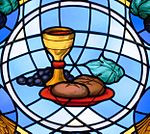
Back Slova ustanovení Czech Einsetzungsworte German Palabras de la Institución Spanish Récit de l'institution French Institusi (liturgi) ID Innstiftelsesordene NB Palavras da Instituição Portuguese Instiftelseorden Swedish
| Part of a series on the |
| Eucharist |
|---|
 |
The Words of Institution (also called the Words of Consecration) are words echoing those of Jesus himself at his Last Supper that, when consecrating bread and wine, Christian Eucharistic liturgies include in a narrative of that event. Eucharistic scholars sometimes refer to them simply as the verba (Latin for "words").
Almost all existing ancient Christian Churches explicitly include the Words of Institution in their Eucharistic celebrations, and consider them necessary for the validity of the sacrament. This is the practice of the Catholic Church's Latin liturgical rites and Eastern Catholic liturgies, the Eastern Orthodox Church, and all the churches of Oriental Orthodoxy, including the Armenian, the Coptic, the Ethiopian and the Malankara, as well as the Anglican Communion, Lutheran Churches, Methodist Churches and Reformed Churches.[1] The only ancient Eucharistic ritual still in use that does not explicitly contain the Words of Institution is the Holy Qurbana of Addai and Mari, used for part of the year by the Assyrian and the Ancient Church of the East. The Chaldean Catholic Church and the Syro-Malabar Catholic Church, two of the Eastern Catholic Churches, use the same Anaphora, but insert in it the Words of Institution. However, groups authorized by the Catholic Church to review the Qurbana recognized the validity of this Eucharistic celebration in its original form, without explicit mention of the Words of Institution, saying that "the words of Eucharistic Institution are indeed present in the Anaphora of Addai and Mari, not in a coherent narrative way and ad litteram, but rather in a dispersed euchological way, that is, integrated in successive prayers of thanksgiving, praise and intercession."[2]
No formula of Words of Institution in any liturgy is claimed to be an exact reproduction of words that Jesus used, presumably in the Aramaic language, at his Last Supper. The formulas generally combine words from the Gospels of Mark, Matthew and Luke and the Pauline account in 1 Corinthians 11:24–25. They may even insert other words, such as the phrase "Mysterium fidei", which for many centuries was found within the Roman Rite's Words of Institution, until that phrase was placed after it in 1970, and has a counterpart in the Syrian liturgy's τὸ μυστήριον τῆς καινῆς διαθήκης ("the mystery of the new covenant").[3]
- ^ Gordon-Taylor, Benjamin; Day, Juliette (12 December 2016). The Study of Liturgy and Worship: An Alcuin Guide. Liturgical Press. p. 177. ISBN 9780814663356.
- ^ Guidelines for admission to the Eucharist between the Chaldean Church and the Assyrian Church of the East
- ^ Hans Lietzmann, (translator: H. G. Reeve), Brill Archive, 1958, p. 511
© MMXXIII Rich X Search. We shall prevail. All rights reserved. Rich X Search